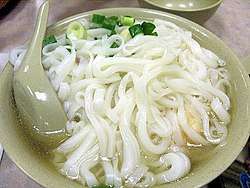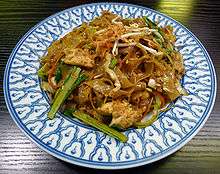Shahe fen
 A thinner version of Shahe fen | |
| Alternative names | Hor fun, many others |
|---|---|
| Type | Chinese noodles |
| Place of origin | China |
| Region or state | Shahe District |
| Main ingredients | Rice |
| Shahe fen | |||||||||||||||||||
| Chinese | 沙河粉 | ||||||||||||||||||
|---|---|---|---|---|---|---|---|---|---|---|---|---|---|---|---|---|---|---|---|
| |||||||||||||||||||
| hefen | |||||||||||||||||||
| Chinese | 河粉 | ||||||||||||||||||
| |||||||||||||||||||
Shahe fen or he fen is a type of wide Chinese noodle made from rice.[1]
Shahe fen is often stir fried with meat and vegetables in a dish called chao fen (炒粉; pinyin: chǎo fěn). While chao fen is a transliteration of Mandarin, chow fun from Cantonese is the name to which this dish is most often referred in Chinese restaurants in North America.
Names
While shahe fen and he fen are transliterations based on Mandarin, there are numerous other transliterations based on Cantonese, which include ho fun, hofoen (a Dutch transliteration in Suriname), hor fun, sar hor fun, etc. In addition, shahe fen is often synonymously called kway teow (粿條), literally "ricecake strips", transliteration based on Min Nan Chinese, POJ: kóe-tiâu) or guotiao (Mandarin pinyin: guǒtiáo), as in the name of a dish called char kway teow. However, shahe fen and kway teow are strictly and technically not the same (the latter being essentially ricecakes sliced into strips) and the Min Nans in general still consciously make a distinction between shahe fen and kway teow in their speech. "Hor fun" is perfected by the Cantonese and is thin and tapered like a tape with some porous areas that absorbs the gravy, taste and flavour of the broth because it contains less starchy content which has been stripped away during the production process. In contrast, guotiao or kuay teow is dense, and less absorbent and contains a higher level of starch and is more impermeable to absorbing flavours, thus the latter has to be soaked for a longer period of time in the dish preparation usually for a day or more, or it is soaked in water first for a long time before it is fried and is "char kway teow". The taste, texture, flavour, ingredients, length, thickness, width, style, density are very different for the Chinese and Asian tastebuds but most foreigners may not be able to tell the difference immediately. Kway Teow has a different origin, from Northeast instead of Central China, and is a modification of the Guo or the Kway making process, the ancient preservation of rice as a starch-filled cake patty, of which the Korean rice strips is one of its descendants, as it was brought as a recipe from China to Chosen Dynasty when the Emperor of China during the Ming Dynasty took the Korean Princess as one of her concubines, this recipe was gifted to the people of Choseon as a betrothal gift to the Korean people. In Hokkien (Fujian) of China, this Kuay went through many influences by the Cantonese version of the shahe hefun. Cantonese culture from the 17th century onwards was thought of as the dominant culture of civilization and culture, of wealth, excess and sophistication, so the ancient Kway underwent modification to become similar to the Standard Cantonese Hor Fun. However, these two strains were spread to Southeast Asia and the world differently, thus they are presented differently in different dishes. Good Chinese restaurants do not mix up or confuse the two, but regular mall versions of Chinese takeout often confuse the two. Original ricecakes or its strips are very stiff in texture (even after cooking), making them unpopular with modern consumers. The other noodle confused by the Westerns is the "nee tai mak" which is like the Hor Fun and the Bee Hoon combined with Milanese pasta.
It is also known in Sabah as da fen (大粉), means "wide vermicelli", due to its similarity of colour and texture to rice vermicelli.
These noodles are called guay tiew sen yai (Thai: เส้นใหญ่, meaning "large rice noodles") in Thailand, kwetiau in Indonesia and Pho in Vietnam as its counterpart version.
Origin
Shahe fen is believed to have originated in the town of Shahe (Chinese: 沙河; pinyin: Shāhé; Jyutping: Sa1ho4*2), now part of the Tianhe District in the city of Guangzhou, in the southern Chinese province of Guangdong, whence their name derives. Shahe fen is typical of southern Chinese cuisine, although similar noodles are also prepared and enjoyed in nearby Southeast Asian nations such as Vietnam, Thailand, Cambodia, Philippines, Malaysia, Indonesia and Singapore, all of which have sizeable Chinese populations.
Types

Shahe fen noodles are white in color, broad, and somewhat slippery. Their texture is elastic and a bit chewy. They do not freeze or dry well and are thus generally (where available) purchased fresh, in strips or sheets that may be cut to the desired width. Where fresh noodles are not available, they may also be purchased packaged in dried form, in various widths.
Shahe fen noodles are very similar to Vietnamese bánh phở noodles, which are likely derived from their Chinese counterpart. Although the phở noodles used in soups may vary in width, wide phở noodles are also common in stir fried dishes. The popular Thai dishes phat si-io and drunken noodles are also made with similar noodles.
Chao fen
Shahe fen is often stir fried with meat and vegetables in a dish called chao fen (炒粉; pinyin: chǎo fěn). While chao fen is a transliteration of Mandarin, chow fun from Cantonese is the name to which this dish is most often referred in Chinese restaurants in North America.
 Beef chow fun
Beef chow fun
See also
References
- ↑ Green, A.; Legato, S.; Casella, C. (2012). Making Artisan Pasta: How to Make a World of Handmade Noodles, Stuffed Pasta, Dumplings, and More. Quarry Books. p. 22. ISBN 978-1-61058-195-0. Retrieved August 26, 2018.
External links
